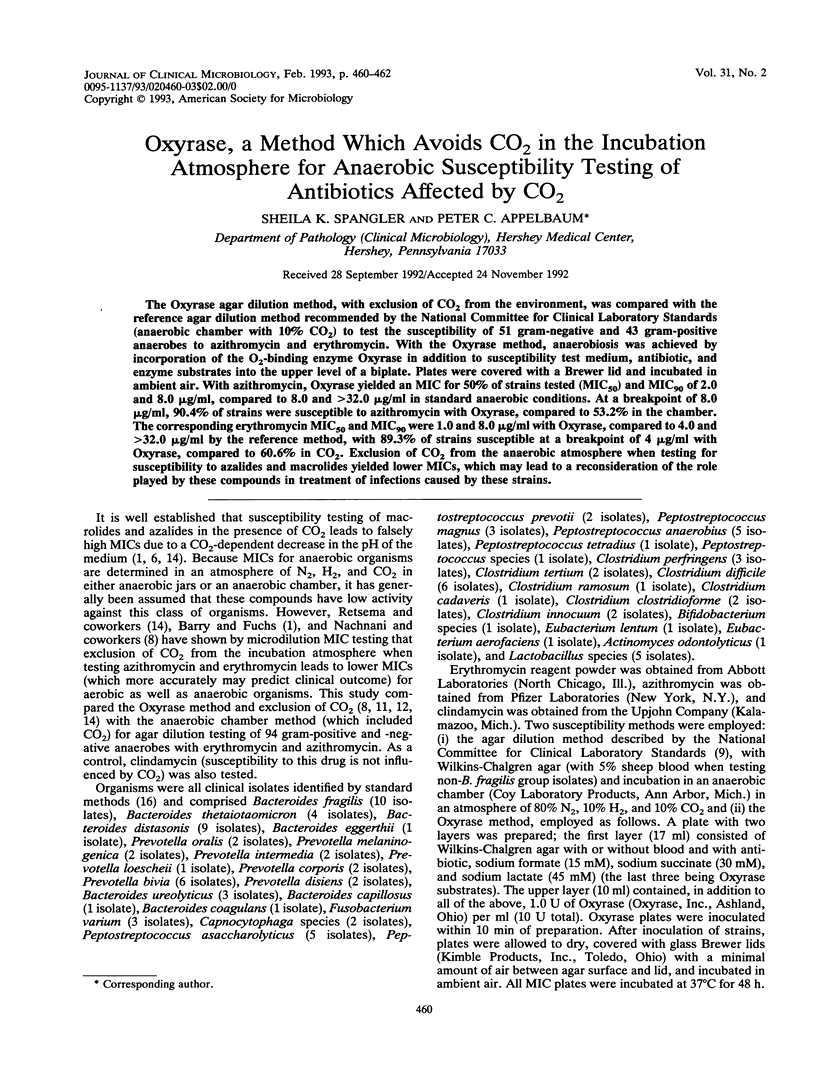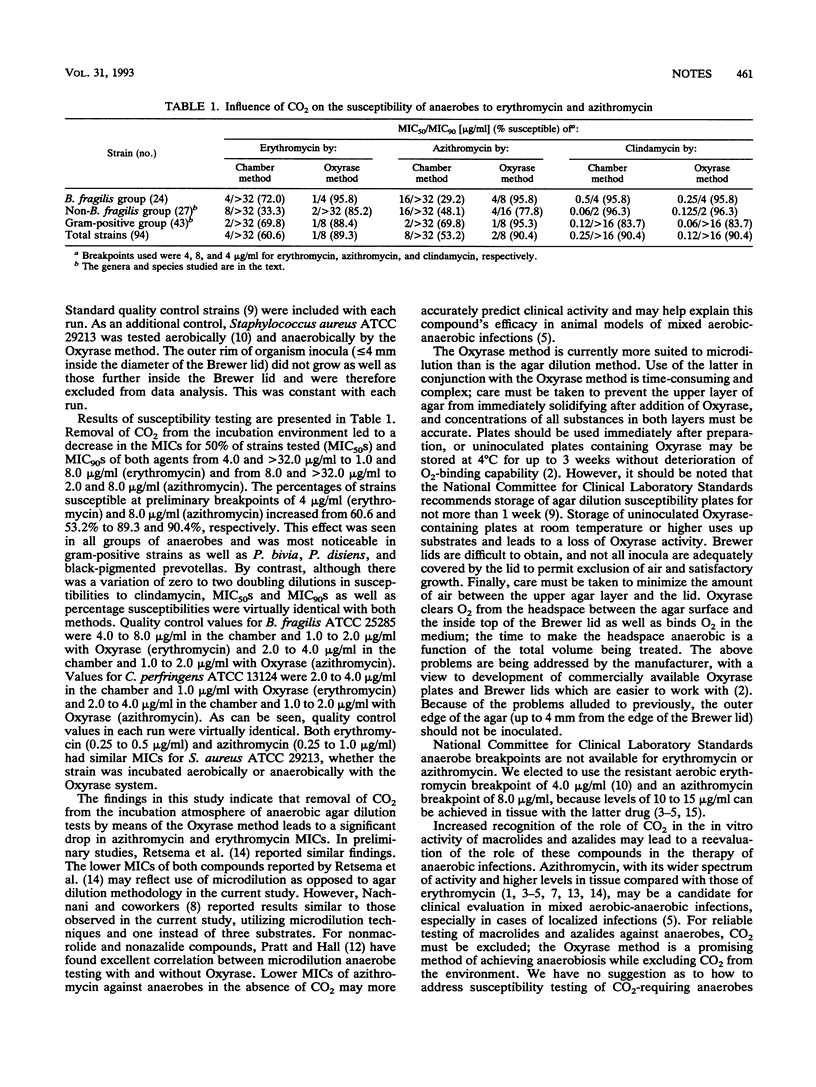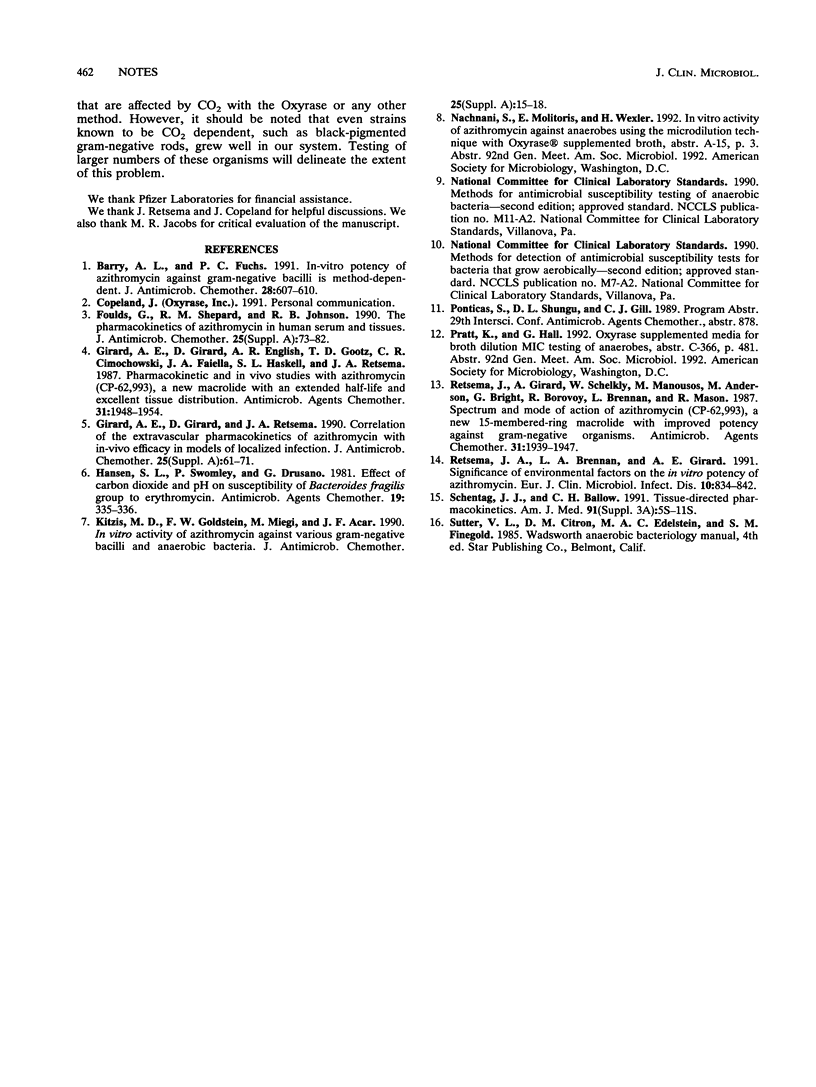Abstract
The Oxyrase agar dilution method, with exclusion of CO2 from the environment, was compared with the reference agar dilution method recommended by the National Committee for Clinical Laboratory Standards (anaerobic chamber with 10% CO2) to test the susceptibility of 51 gram-negative and 43 gram-positive anaerobes to azithromycin and erythromycin. With the Oxyrase method, anaerobiosis was achieved by incorporation of the O2-binding enzyme Oxyrase in addition to susceptibility test medium, antibiotic, and enzyme substrates into the upper level of a biplate. Plates were covered with a Brewer lid and incubated in ambient air. With azithromycin, Oxyrase yielded an MIC for 50% of strains tested (MIC50) and MIC90 of 2.0 and 8.0 micrograms/ml, compared to 8.0 and > 32.0 micrograms/ml in standard anaerobic conditions. At a breakpoint of 8.0 micrograms/ml, 90.4% of strains were susceptible to azithromycin with Oxyrase, compared to 53.2% in the chamber. The corresponding erythromycin MIC50 and MIC90 were 1.0 and 8.0 micrograms/ml with Oxyrase, compared to 4.0 and > 32.0 micrograms/ml by the reference method, with 89.3% of strains susceptible at a breakpoint of 4 micrograms/ml with Oxyrase, compared to 60.6% in CO2. Exclusion of CO2 from the anaerobic atmosphere when testing for susceptibility to azalides and macrolides yielded lower MICs, which may lead to a reconsideration of the role played by these compounds in treatment of infections caused by these strains.
Full text
PDF


Selected References
These references are in PubMed. This may not be the complete list of references from this article.
- Barry A. L., Fuchs P. C. In-vitro potency of azithromycin against gram-negative bacilli is method-dependent. J Antimicrob Chemother. 1991 Oct;28(4):607–610. doi: 10.1093/jac/28.4.607. [DOI] [PubMed] [Google Scholar]
- Foulds G., Shepard R. M., Johnson R. B. The pharmacokinetics of azithromycin in human serum and tissues. J Antimicrob Chemother. 1990 Jan;25 (Suppl A):73–82. doi: 10.1093/jac/25.suppl_a.73. [DOI] [PubMed] [Google Scholar]
- Girard A. E., Girard D., English A. R., Gootz T. D., Cimochowski C. R., Faiella J. A., Haskell S. L., Retsema J. A. Pharmacokinetic and in vivo studies with azithromycin (CP-62,993), a new macrolide with an extended half-life and excellent tissue distribution. Antimicrob Agents Chemother. 1987 Dec;31(12):1948–1954. doi: 10.1128/aac.31.12.1948. [DOI] [PMC free article] [PubMed] [Google Scholar]
- Girard A. E., Girard D., Retsema J. A. Correlation of the extravascular pharmacokinetics of azithromycin with in-vivo efficacy in models of localized infection. J Antimicrob Chemother. 1990 Jan;25 (Suppl A):61–71. doi: 10.1093/jac/25.suppl_a.61. [DOI] [PubMed] [Google Scholar]
- Hansen S. L., Swomley P., Drusano G. Effect of carbon dioxide and pH on susceptibility of Bacteroides fragilis group to erythromycin. Antimicrob Agents Chemother. 1981 Feb;19(2):335–336. doi: 10.1128/aac.19.2.335. [DOI] [PMC free article] [PubMed] [Google Scholar]
- Kitzis M. D., Goldstein F. W., Miégi M., Acar J. F. In-vitro activity of azithromycin against various Gram-negative bacilli and anaerobic bacteria. J Antimicrob Chemother. 1990 Jan;25 (Suppl A):15–18. doi: 10.1093/jac/25.suppl_a.15. [DOI] [PubMed] [Google Scholar]
- Retsema J. A., Brennan L. A., Girard A. E. Effects of environmental factors on the in vitro potency of azithromycin. Eur J Clin Microbiol Infect Dis. 1991 Oct;10(10):834–842. doi: 10.1007/BF01975836. [DOI] [PubMed] [Google Scholar]
- Retsema J., Girard A., Schelkly W., Manousos M., Anderson M., Bright G., Borovoy R., Brennan L., Mason R. Spectrum and mode of action of azithromycin (CP-62,993), a new 15-membered-ring macrolide with improved potency against gram-negative organisms. Antimicrob Agents Chemother. 1987 Dec;31(12):1939–1947. doi: 10.1128/aac.31.12.1939. [DOI] [PMC free article] [PubMed] [Google Scholar]
- Schentag J. J., Ballow C. H. Tissue-directed pharmacokinetics. Am J Med. 1991 Sep 12;91(3A):5S–11S. doi: 10.1016/0002-9343(91)90394-d. [DOI] [PubMed] [Google Scholar]


